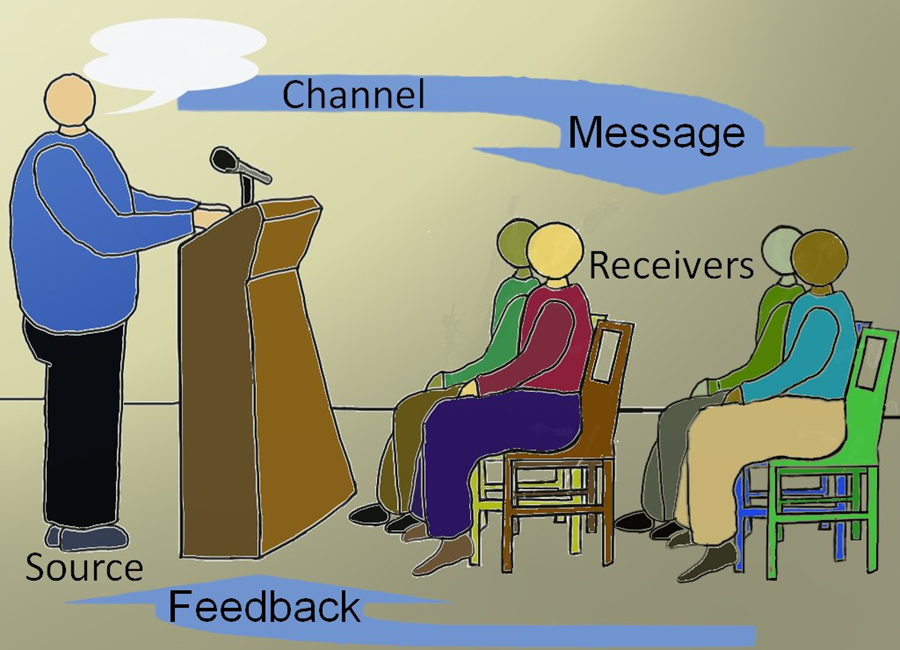1.1: Models of communication
- Page ID
- 152952
What Is Interpersonal Communication?

Credit: (CC0, Fauxels, Pexels)
Let’s play “Latin and Greek Derivatives.” “Inter” means between. “Personal” is derived from the Latin word “personalis” and means pertaining to one person. So, interpersonal means communication between individual people. It is different than group communication or public communication. We often engage in interpersonal communication in dyads, which means between two people.
But interpersonal communication isn’t just about the number of people involved. Rather, it occurs when people communicate with each other as unique individuals. Interpersonal communication is an exchange where there is desire and motivation to get to know another person better, as an individual.
This gets into the question of how people perceive you – of what is your personal brand. When we hear the word brand, we think of some logo or other device that represents a company or a person. Below are the logos of some colleges and universities. You may recognize some, but can you tell what these institutions are known for? What’s it like to be a student or teacher there?












(The images are left to right, top to bottom: Prince George’s Community College. Harvard University, College of Southern Maryland, Howard University, Sweet Briar College, University of Maryland, U.S. Military Academy at West Point, and Bowie State University, Indiana University, University of District of Columbia, Towson University and Morgan State University).
Each of these images will stir emotions in people who are familiar with the institution. But they don’t tell us a great deal about the institution. Are they academically rigorous? Are they HBCU? Are they party schools? How successful are their graduates? From this exercise we can deduce what a brand is not. It’s not an logo, which is a symbol or other design adopted by an organization to identify its products, uniform, vehicles, etc. So, what is a brand?
Ignyte Brands, a consultancy, explains a brand as “the way a product, company, or individual is perceived by those who experience it. Much more than just a name or a logo, a brand is the recognizable feeling these assets evoke.” Think of Apple. What is its brand? It's not just computers, iPhones, and iWatches. Nor is it slick commercials. And it’s certainly not just the logo of an apple with a bite out of it.
It turns out the Apple brand isn’t any “thing” in the classical sense of the word. You can’t hold it or hear it or even touch it. That’s because brands live in the mind. They live in the minds of everyone who experiences them: employees, investors, the media, and, perhaps most importantly, customers. Simply put, brands are perceptions. (Emphasis added)
(Lischer, 2022)
- Test your understanding: In 500 words or less, describe your college or employer’s brand as perceived by those inside the organization (students, faculty, staff, alumni) and those outside the organization.
When we think about interpersonal communication, we think in several different components.
1. The communicators: There are at least two communicators involved in all interpersonal communication – the speaker and the receiver.
2. The message: It can be conveyed in many ways—words, body language, tone of voice, gestures and other indicators.
3. Noise: In addition to what we discussed above, noise can include accents, jargon, language barriers and more.
4. Context: “The process of communication is influenced by the context in which it occurs. The emotional climate and expectations of the people, the place of occurrence, and social, political cultural and environmental conditions comprise context” (CommunicationTheory.org, 2022).
5. Channel: A message is sent through a specific channel or medium.
Part of how your message will be received is how you, the communicator, are perceived. Watch Ann Bastianelli, a teaching professor of marketing at the Kelley School of Business at Indiana University, discuss the importance of your personal brand. Be prepared to discuss this video in class. (Prof. Bastianelli will explain her professional background during the talk).
Video \(\PageIndex{1}\): Powerful Personal Branding (Ann Bastianelli)
Sometimes a picture is worth 1,000 words. So, researchers develop “models” to provide graphical representations of theories or processes. The models are almost always simplified, but they do help. When it comes to communication, the basic models demonstrate the process of one-way or broadcast communication and two-way communication.
The linear model is straight-forward. Think of a televised newscast. The newscaster sits in a studio, reads off a teleprompter, the message goes through the air to your TV set and into your eyes and ears. In this example, the newscaster is the source, the channel is the station you are watching and you are the receiver. Or, think of a college professor in a lecture hall giving a lecture to 200 students
Now take a look at this image of the transactional model:

In many respects, this is identical to the linear model. You can see this is a representation of a lecture. The source is the speaker, the channel is oral, which is how the message is delivered, and the receivers are the students. But unlike in the linear model, the receivers can give feedback by asking questions or making comments. The ability to give feedback is what makes it a transactional model.
- Can you think of other examples of both the linear and transactional model?
If you’re like me, often you don’t really “hear” what the newscaster is saying. If my wife shuts off the TV and says, “What did he just say,” I’m often left sputtering. Why? Because I’ve been reading my phone. Or thinking about an argument I had with a co-worker. Or fantasizing about my new car. This is what we call “noise.” Noise is not in the graphic above, but understanding noise is essential to being an effective communicator. Noise can be many things. It can be the sound of a busy highway or of construction outside your room. It can be birds chirping. It can also be the sound of a television set, streaming video or similar media. But it can also be noise in your head.
Have you ever been listening to someone – perhaps your professor, a speaker or someone on TV – and found your attention drifting away? The average person speaks about 150 words a minute (Villazon, 2022, June 20), while the brain can process at about 600 words a minute. So, for every second the brain is active understanding what your boss says, it’s inactive for three seconds. Is it any wonder that we find our attention drifting away when listening to someone? That, too, is noise.
(The world record for speech is 637 words a minute, but at that speed it is not understandable. Beyond 300 words a minute, it’s really impossible to make out individual words clearly. So how do they know the world record for speech is 637? Researchers recorded Steve Woodmore, an English comedian and presenter, and then slowed it way down to verify what he was saying.)
Noise can come from many sources. Sometimes we’re angry at something someone said or did. So, while we appear to be listening to our boss, internally we are seething and thinking things like, “how dare he!” Or, on a date, while we are listening to our partner, we’re thinking, “does she like me?,” or, “is this the time to sneak a kiss?” When I was young, I listened to shortwave radio. Often understanding the program was a challenge – there was static, crackle and pop; there might be language barriers; the signal might have faded.
Take a listen to Radio Brazzaville:
Video \(\PageIndex{2}\): https://www.youtube.com/watch?v=jU7BbNekY8g
You see how noise can make understanding very difficult There are three types of noise – external, internal and semantic noise. Watch this video to understand the difference between the three.
We’ll examine noise more in the chapter on listening.
References
Communication Theory (2022, June 20). Interpersonal communication. https://www.communicationtheory.org/...communication/
Lischer, B. (2022, June 20). What is a brand? Ignyte Brands. https://www.ignytebrands.com/what-is-a-brand/
Villazon, L. (2022, June 20). What's the upper limit on how fast someone can talk? Science Fact. https://www.sciencefocus.com/the-hum...eone-can-talk/

